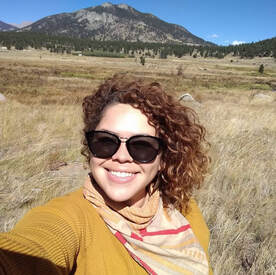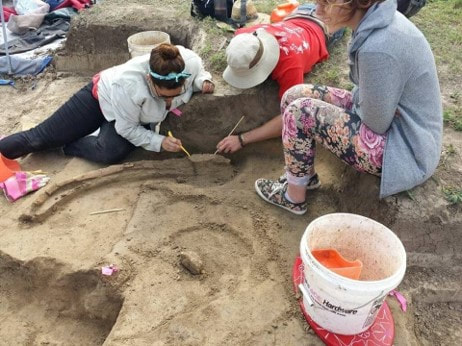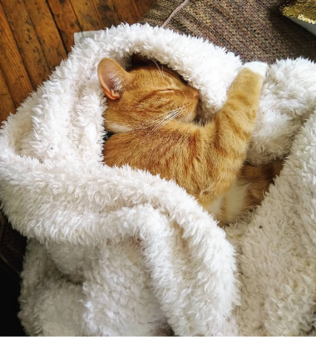10/8/2020
By Cheyanne Lewis
@chylew

Leila Joyce Seals, a current PhD student at the University of Kansas and creator of Blog of the LadyGeos. #RockyMountainsSelfie courtesy of Leila Joyce Seals.
In celebration of #BlackinSciComm week, I got to sit and chat (virtually) with Leila Joyce Seals (@GeoarchAndLush on Twitter), a geoarchaeology PhD candidate at the University of Kansas. I’m excited to share her journey as a science communicator, and how her experiences as a biracial woman have influenced her career and education.
Birth of a Scientist
Leila tells stories of walking along the rocks of Puerto Rico, where she accompanied her father doing field work, maneuvering around outcrops and under barbed wire fences. With her father being a geologist, she often explored the valleys with him, running through the hills and thinking about the people of the past that had stood in her place. Although she enjoyed these all-day escapades, she couldn’t help but wonder how the world around her, the landscapes she had come to love, had existed hundreds and thousands of years ago.
As time passed, her interests became much more complex. They inevitably became interdisciplinary, a cross between geology, archaeology, and anthropology as a gateway to study her favorite subjects: the past, people, and landscapes.
After obtaining her B.S. in Anthropology from Binghamton University in New York state, she found herself flying back to the place she called home – Puerto Rico. There, at the University of Puerto Rico-Mayagüez, Leila earned her M.S. in Geology. As someone who had always done “other stuff” in addition to school, she filled her schedule by running student organizations and teaching at the Bilingual Writing Center. Her time in Puerto Rico not only solidified her passions for geoarchaeology, but for science communication as well. Even if she was translating for subjects other than science, she still enjoyed breaking down complex topics into digestible pieces of information. She got to strengthen her skills as a communicator while also helping her peers succeed in their studies.
Science communication is more than just regurgitating the facts. The goal is to talk about science in a way that resonates with other people and opens doors that may have otherwise remained closed.
Currently, Leila is finishing her PhD at the University of Kansas focusing on Quaternary landscape evolution of the Big Blue River valley and its implications for PaleoIndian archeology. Her studies focus on how the landscape changed over time and how those changes might have affected the people living within the vicinity. To put it simply, her research “helps provide context for the archaeological record.”
Earlier this year, Leila worked with The Geology Project, a geoscience literacy and social media project, to discuss the Puerto Rico seismic sequence.In December of 2019, there was a succession of aftershocks that rattled Puerto Rico after a 4.7 magnitude earthquake. In January, it was followed by a magnitude 6.4 mainshock. The island had not seen an earthquake of this magnitude for over a century, and it is predicted that the aftershocks will continue for up to another 10 years. Even though it is no longer a popular topic of discussion, Leila is still interested in spreading awareness and staying updated with the progression of the seismic sequence.
In addition to her studies, she also volunteers with Explorations in Archaeology (EiA), a graduate-run lecture series at the University of Kansas. She is excited that they will be virtual this year, making it more open and accessible to the public.

Road to Science Communication
Working as a peer language tutor in the bilingual center helped her understand the basics of science communication and the many ways in which people take in information. Not only did she translate between languages (as one often does with science for lay audiences), but she learned that 30 seconds of good conversation is “more memorable than a rabbit hole on a Wikipedia page.” At this point, we shared a good laugh as I’m sure many students understand the struggles of sifting through loads of unnecessary information on Wikipedia, only to find the tidbit you were looking for at the very bottom of the page. For her, science communication is more than just regurgitating the facts. The goal is to talk about science in a way that resonates with other people and opens doors that may have otherwise remained closed.
Part of her job as a communicator is to create context and translate meaning, both literally and figuratively. As she opened up about the struggles she experienced while getting her Master’s degree, she expressed how “English has become the de facto language of science,” and that it’s important to consider language barriers and actively try to fight against them.
Science communication is magical, and as an omniscient voice narrating the science, she aims to “keep the wonder in it.”
As many graduate students and scientists know, there are times when motivation is fleeting and obstacles become increasingly difficult to overcome. These instances can be more frequent for women of color. These experiences are part of the reason why Leila jumped into building Blog of the Lady Geos. The blog has become a virtual “Wine and Whine” of sorts, a place for her and her team of early career geoscientists to complain about their problems, share their latest adventures, and provide support for one another as well as their readers.
Although creating a project from the ground up isn’t easy, Leila described the experience as fun and stimulating: “I was definitely not in a place to think about the potential for failure. So I’m glad I did what I usually do, which is jump in and figure it out later.”
Navigating Higher Education as a BIPOC
From one mixed woman to another, I deeply resonate with many of Leila’s experiences. We both share the understanding that stories of BIPOC can often come across as “war stories” —they distract from our work and are tokenizing.
“Staying quiet about problems and problematic behavior will keep you more or less under the radar, but eats [at] your mental health and soul. Speaking up, no matter how carefully or politely, comes back to bite you… At best, speaking up about an issue means you’ll (1) be asked what you think should be done to remedy the issue [or a] similar issue – but always within the bounds of what doesn’t in any way rock the boat, and (2) continually asked to do more work or put yourself out there in front of more people.”
In terms of advice for non-BIPOC mentors or at predominantly white institutions (PWIs), she believes that if people wanted the system to change, then the institutions and organizations would put more effort into doing so rather than relying on BIPOC to consistently advocate for themselves and provide input. More often than not, they are putting in work for little to no compensation.
In order to improve the recruitment and retention of Black students and faculty, more has to be done than a few quick changes. Most issues that need fixing aren’t necessarily related to race (abusive faculty, out-of-pocket travel expenses, living circumstances, etc.), but regardless, they can still disproportionately affect BIPOC.
For Leila, her work is far from done. Regardless of the obstacles she faces, she still loves expressing herself, unapologetically talking about science whenever she gets the chance.
“The most rewarding thing is talking to people who see a little of themselves in me. Whether that’s my giant head of curls, penchant for red lipstick, glittery nails, or anything else.




Leave a Reply